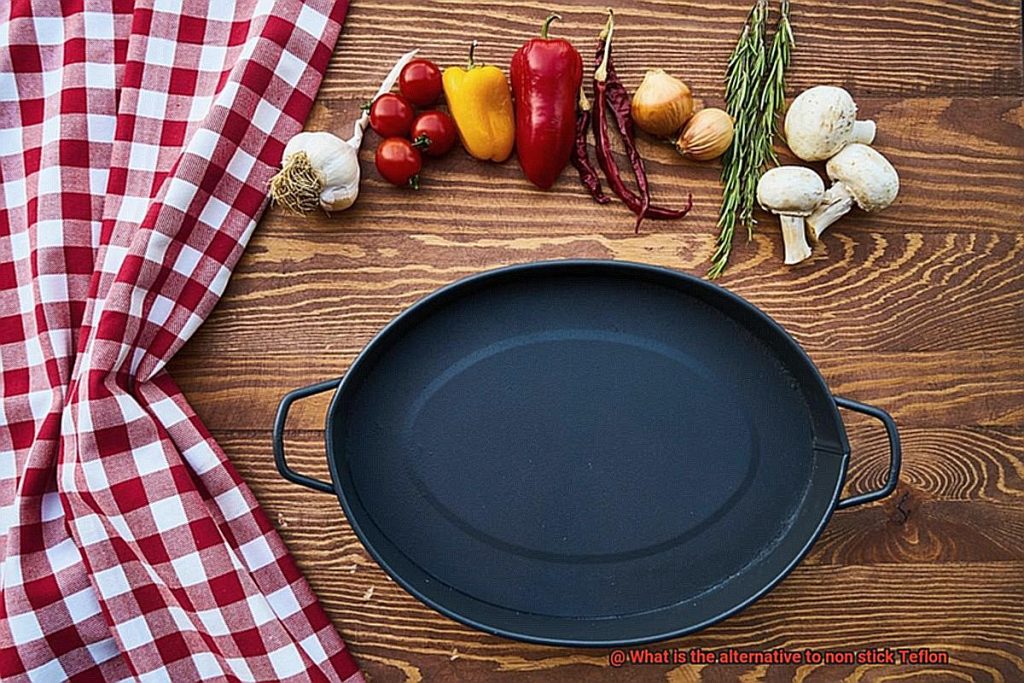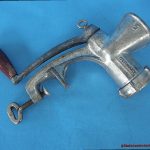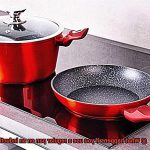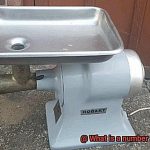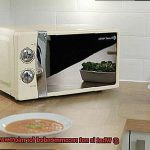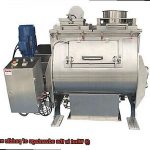Are you tired of worrying about the potential dangers of non-stick Teflon cookware? It’s time to say goodbye to those toxic fumes and hello to safer, healthier alternatives.
Luckily, there are plenty of options out there that can keep your cooking chemical-free without sacrificing quality. In this blog post, we’ll explore some of the best alternatives to non-stick Teflon cookware, so you can make an informed decision for your kitchen.
Cast iron pans have been a favorite for generations – they’re incredibly durable and provide excellent heat retention. Ceramic cookware is another great option, with its non-toxic properties and easy-to-clean surface. And let’s not forget about stainless steel – a reliable choice that provides longevity and a non-reactive surface.
Whether you’re whipping up gourmet meals or just trying to feed yourself on a budget, understanding the alternatives to non-stick Teflon is crucial for a healthy and safe cooking experience. So keep reading as we dive into the benefits, drawbacks, and best uses for each option.
Contents
What is Non-Stick Teflon?
Non-stick Teflon is a coating that has been used on cookware for decades. It’s made from polytetrafluoroethylene (PTFE), a synthetic fluoropolymer of tetrafluoroethylene that was trademarked as Teflon by DuPont in 194While Teflon has made cooking and cleaning easier, there have been concerns about its safety due to the chemicals it releases when heated at high temperatures.
Perfluorooctanoic acid (PFOA), the chemical released by Teflon when heated, has been linked to health issues like cancer and developmental problems. In response to these concerns, many companies have started to offer alternatives to non-stick Teflon cookware.
Ceramic coatings are a popular alternative because they’re non-toxic, scratch-resistant, and can withstand high temperatures. They’re also easy to clean, making them perfect for those who love using metal utensils in the kitchen.
Cast iron cookware is another great option for those who want to avoid chemicals in their cookware. It’s highly durable and can last for generations if properly cared for. Plus, it’s perfect for grilling and searing and can be used on all types of stovetops.
Stainless steel cookware is also considered a safer option compared to Teflon because of its durability and non-reactive properties. While it may not be as non-stick as Teflon or ceramic, proper seasoning and care can provide a great cooking experience.
Anodized aluminum cookware is lightweight and durable and has a non-stick surface that doesn’t require additional coatings. It’s perfect for those who want a low-maintenance option that can withstand high temperatures.
Health Risks Associated with Non-Stick Teflon
Step into any kitchen, and you’ll likely find non-stick Teflon cookware lining the shelves. It’s convenient, easy to use, and makes cleanup a breeze. However, studies have shown that this popular cookware choice also comes with potential health risks.
The culprit is perfluorooctanoic acid (PFOA), a chemical used in the manufacturing of Teflon. PFOA has been linked to a range of health problems, including cancer, liver damage, and thyroid disease. Even more concerning, when non-stick Teflon cookware is heated to high temperatures, it can release toxic fumes that can harm both humans and pets.
But it doesn’t end there. When the non-stick coating on Teflon cookware starts to wear off or scratch, small particles can be released into food. These particles can be ingested and potentially cause health problems. Plus, they can contribute to pollution when they end up in the environment.
So what’s the alternative to non-stick Teflon cookware? Fortunately, there are many options available that are safer for both you and the environment. Here are just a few:
- Cast iron: Ideal for grilling, cast iron retains heat well and provides a beautiful sear on meats. With proper care, it can last a lifetime.
- Stainless steel: Durable and easy to clean, stainless steel doesn’t release harmful fumes when heated.
- Ceramic and glass: These non-toxic options won’t leach chemicals into your food and come in a range of colors and patterns to match your kitchen decor.
When choosing safer cookware options, it’s important to consider your cooking needs and preferences. Each type of cookware has its advantages and disadvantages, so pick what works best for you.
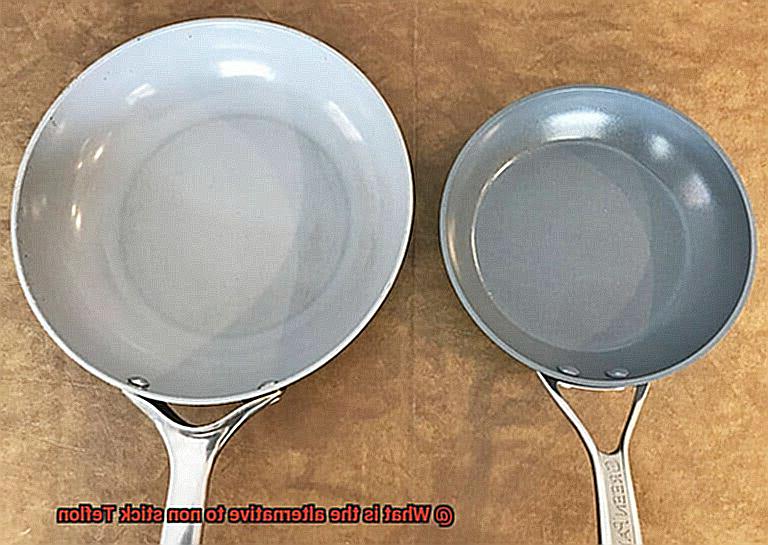
Alternatives to Non-Stick Teflon Cookware
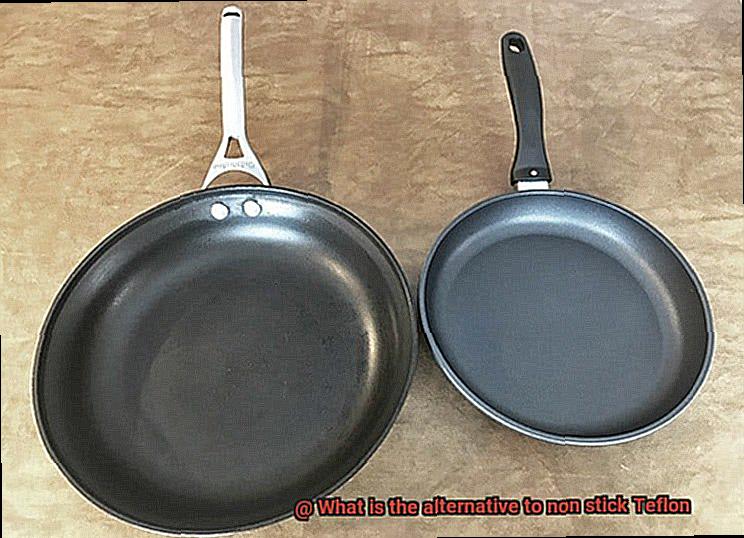
While it may be convenient, the potential dangers of exposure to toxic chemicals and fumes have led many home cooks to seek out safer alternatives. In this post, I will share some of the best alternatives to non-stick Teflon cookware that are both safe and effective.
First on the list is ceramic cookware. Made from natural materials like clay and sand, ceramic cookware is free from harmful chemicals like Teflon. Its non-stick surface makes cooking and cleaning a breeze. Whether you’re frying an egg or baking a casserole, ceramic cookware is a versatile option that can be used on all types of stovetops and in the oven.
Next up is cast iron cookware. This tried-and-true option has been used for centuries and is known for its durability and versatility. Cast iron can be used on all types of stovetops and in the oven, and with proper care, it can last a lifetime. While it requires a bit more maintenance than other types of cookware, many home cooks swear by cast iron’s ability to evenly distribute heat and create a perfect sear on meats.
If you prefer a sleeker look in your kitchen, stainless steel cookware is another great alternative to non-stick Teflon. Stainless steel is a durable material that can be used on all types of stovetops and requires minimal maintenance. While it doesn’t have a non-stick surface like Teflon, stainless steel does have a natural non-stick quality if heated properly. Plus, it’s easy to clean and doesn’t require any special care.
Finally, there are non-stick alternatives to Teflon cookware that use other types of coatings such as ceramic or diamond-infused coatings. These coatings are designed to be non-toxic and more durable than traditional Teflon coatings. However, it’s important to do your research and make sure that these coatings are safe and effective before making a purchase.
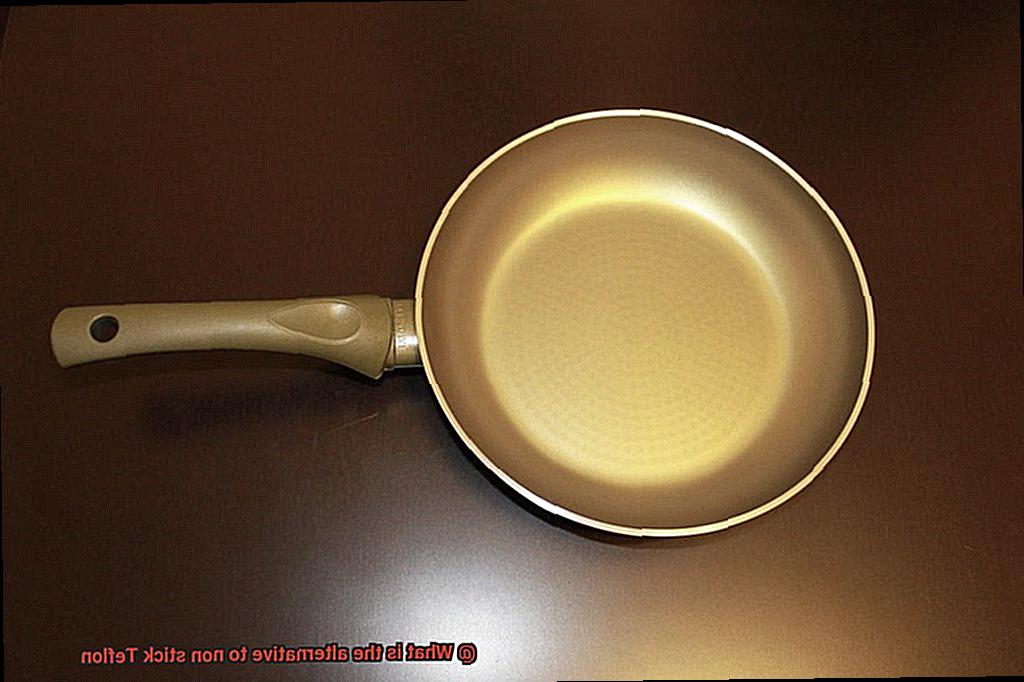
Ceramic Cookware
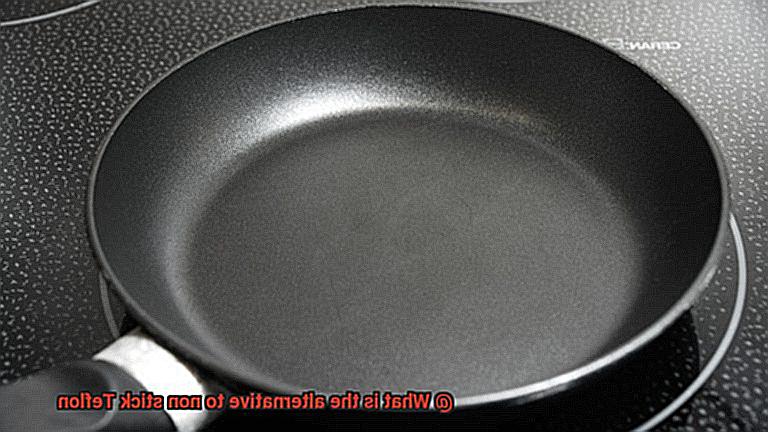
It’s time to switch to a healthier, more durable, and versatile alternative – ceramic cookware.
Made from natural materials like clay, sand, and minerals, ceramic cookware is a safer option for your cooking needs. It doesn’t contain any harmful chemicals or toxins, so you can cook with peace of mind.
One of the best advantages of ceramic cookware is its even heat distribution. This means that your food will cook evenly, preventing hotspots that can result in overcooked or undercooked meals. Ceramic cookware is also non-reactive, making it safe to use with acidic foods like tomatoes or citrus fruits. Unlike non-stick Teflon coatings, ceramic cookware won’t break down and release toxic fumes when exposed to high temperatures.
Ceramic cookware is also incredibly durable and easy to clean. It can withstand high temperatures without scratching or chipping, making it perfect for grilling and searing. Unlike Teflon, ceramic cookware is dishwasher safe and doesn’t require any special cleaning tools or techniques.
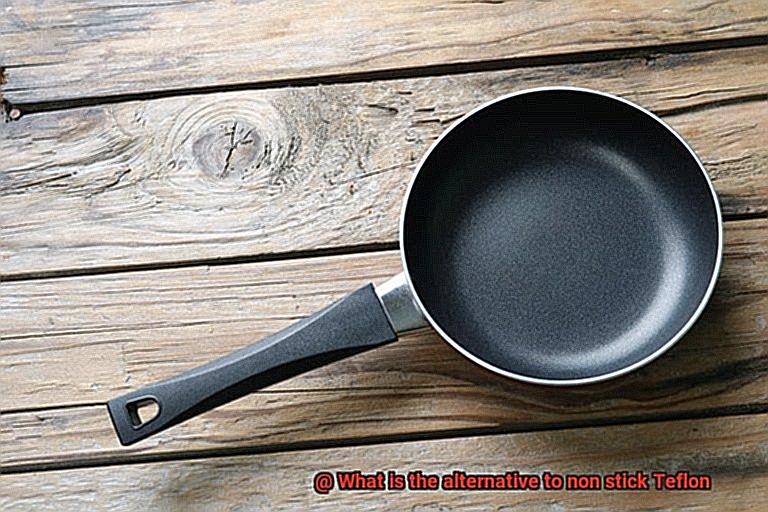
While ceramic cookware may be heavier and bulkier than other types of non-stick cookware, it’s worth the investment in the long run. Its longevity and health benefits make it a smart choice for any home chef.
Cast Iron Cookware
Look no further than cast iron cookware. This durable alternative to non-stick Teflon cookware has been used for centuries and is known for its exceptional even heating and heat retention abilities.
Cast iron cookware is made by pouring molten iron into a mold and allowing it to cool and solidify. The result is a heavy and rugged piece of cookware with a rough surface that can be seasoned to prevent food from sticking. One of the benefits of cast iron cookware is its versatility – it can be used on any heat source, including gas, electric, and even induction stoves. It can also be used in the oven or on the grill.
Whether you’re searing meats, frying eggs, baking cornbread, or making pizza, cast iron cookware can handle all your cooking needs. It’s virtually indestructible and can withstand high temperatures, rough handling, and years of use without showing any signs of wear and tear. In fact, some people argue that cast iron cookware improves with age as it becomes more seasoned and develops a natural non-stick surface.
However, it’s important to note that cast iron cookware requires seasoning before use to create a non-stick coating. This involves rubbing the surface with oil and heating it in the oven for several hours. Additionally, careful cleaning is required to prevent rusting – it should never be soaked in water or put in the dishwasher.
Stainless Steel Cookware
Say goodbye to constantly replacing your non-stick Teflon cookware and hello to the world of stainless steel. Not only is it durable and versatile, but it’s also a safer option for your health. Stainless steel cookware boasts a non-reactive surface, meaning it won’t interact with acidic or alkaline foods, avoiding any harmful chemicals from leaching into your meals.
This incredible material is made from a combination of metals, including nickel and chromium, creating a strong and resistant surface that can withstand high temperatures without warping or scratching. Its ability to sear and brown food evenly is unmatched, making it perfect for grilling meat and vegetables. The even heat distribution and non-stick surface when heated properly allow you to cook your dishes to perfection every time. Plus, stainless steel pots and pans are oven safe too, making them ideal for dishes that require both stove-top and oven cooking.
However, cleaning stainless steel cookware can be more of a challenge than non-stick Teflon. If not heated properly or if the pan isn’t adequately oiled, food may stick to the surface. But fear not. Using a high-quality stainless steel cleaner or soaking the pan in hot, soapy water can help remove any stuck-on food.
Pros and Cons of Each Alternative to Non-Stick Teflon
There are many alternative options available in the market that can cater to your cooking needs. As an expert on this topic, I have researched and compiled a comprehensive list of the pros and cons of each alternative to non-stick Teflon. Let’s delve into each option in detail.
First off, we have ceramic-coated cookware. It is a popular alternative that is non-stick, scratch-resistant, and easy to clean. Not to mention, it is free from harmful chemicals like PFOA and PFAS. However, this type of cookware can be more expensive than Teflon-coated cookware and may not be as durable as other alternatives.
Next up, we have stainless steel cookware. The material is known for its durability and longevity. It is also non-reactive, meaning it does not react with acidic foods like tomatoes or citrus fruits. However, cleaning stainless steel cookware can be a challenge, and food can easily stick to the surface if not properly heated or lubricated.
Cast iron cookware is another great option that is renowned for its versatility and durability. It can be used on the stovetop, in the oven, or even on the grill. With proper maintenance, cast iron cookware can last for generations. However, it requires seasoning before use and can be heavy and difficult to handle.
Last but not least, there is anodized aluminum cookware. It is non-stick, scratch-resistant, and easy to clean. The electrochemical process used to treat the aluminum makes it harder and more durable than regular aluminum. However, this type of cookware can be more expensive than other alternatives and may not be as widely available in the market.
To sum up, each alternative to non-stick Teflon has its own set of advantages and disadvantages. It is crucial to weigh these factors before making a decision. If non-toxic materials are your priority, ceramic-coated cookware is an excellent choice. For durability and longevity, stainless steel cookware is a reliable option. Cast iron cookware is perfect if you want a versatile option that can handle any cooking task. And if you’re willing to invest in high-quality cookware that’s easy to clean and built to last, anodized aluminum cookware is a great choice.
Rn_txCvfSx0″ >
Conclusion
In conclusion, if you’re ready to ditch the dangers of non-stick Teflon cookware, there are plenty of safe and healthy alternatives to choose from. Cast iron, ceramic, stainless steel, and anodized aluminum cookware are all excellent options that can keep your cooking chemical-free without sacrificing quality. It’s important to consider your cooking needs and preferences before making a decision on which alternative is right for you.
Non-stick Teflon cookware may seem like a convenient option, but it comes with potential health risks. The chemical used in its manufacturing process, perfluorooctanoic acid (PFOA), has been linked to various health problems. When heated to high temperatures, non-stick Teflon cookware can release toxic fumes that can harm humans and pets alike. Moreover, when the non-stick coating starts to wear off or scratch, small particles can contaminate your food.
Thankfully, there are many safer alternatives available that are better for both you and the environment. Ceramic-coated cookware is nontoxic and easy to clean. Stainless steel is durable and doesn’t emit harmful fumes when heated correctly. Cast iron is versatile and highly durable if properly cared for. Anodized aluminum is lightweight and robust with a non-stick surface that doesn’t require additional coatings.
By understanding the pros and cons of each alternative option available, you can make an informed decision for your kitchen that will provide a healthy and safe cooking experience.

